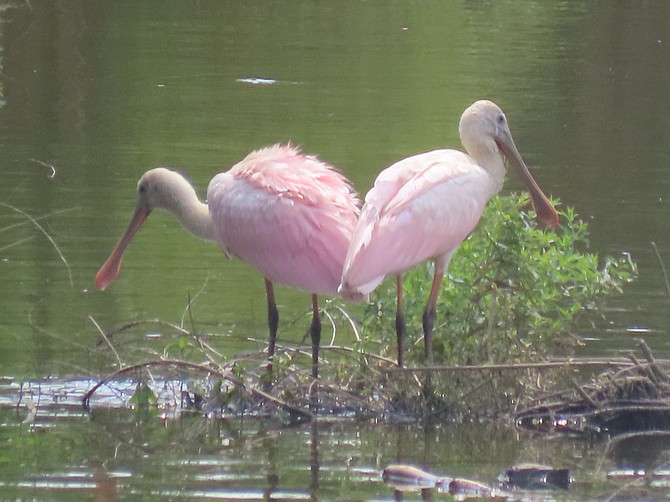Two pink roseate spoonbills caused quite the sensation among their human observers the week of July 10. On July 12, Joan Mashburn photographed two that she believes were displaying courtship behavior in Hunting Creek, although they are likely too young to breed, she clarifies.
Larry Meade, president of the Northern Virginia Bird Club, says, “These roseate spoonbills seem to be mostly young birds that have dispersed north. There are a few spoonbills in Virginia and Maryland this year, but not as many as there were throughout the region in 2021. I am not sure what is pushing them north from their normal range, well south of here along the Gulf Coast and Florida.”
The young birds that Mashburn captured with her camera are paler than adult spoonbills, which get a darker pink plumage in their third year, according to Meade. “Roseate spoonbills get their pink coloration from the foods they eat,” according to Cornell University’s All about Birds. “Crustaceans and other aquatic invertebrates contain pigments called carotenoids that help turn their feathers pink.” Adults have scarlet patches and a yellowish-green head.
These wading birds have six- to seven-inch, spatula-like bills resembling long-handled spoons that they sweep back and forth to feed. As they slowly step across the water, they scoop up fish, crustaceans and other prey, especially small aquatic creatures, as the water passes through their bills. The birds can be up to 33 inches tall, weigh between 2.5 and 4 pounds and have a 47-to-50-inch wingspan.
Recently, spoonbills have been reported in a few other areas, including Washington, D.C.’s Kenilworth Gardens, but unlike 2021, when throngs of people flocked to Huntley Meadows Park to see them, there have been no reports of them there this year so far.
North America has one of six worldwide roseate spoonbill species. They breed mostly in Florida and Texas and are typically seen in coastal southeastern U.S. states and South America. They are common in coastal Texas year-round and young ones may stray “far north and inland” after breeding, reports the National Audubon Society. In the 1860s, plume hunters almost caused their extermination, reports Audubon.
“These birds were clearly displaying courtship behavior and followed each other closely, which is another indication of courtship,” said Mashburn. “It was magical to watch.”

